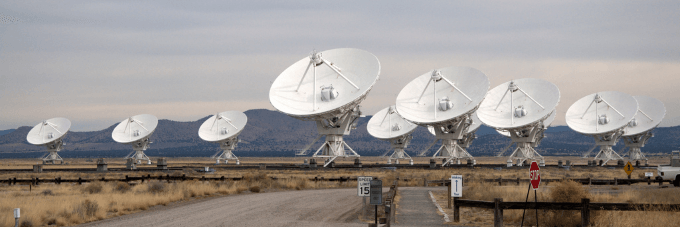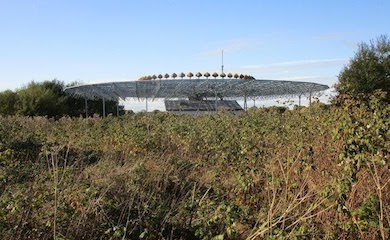Radio telescopes detect weak radio signals from outer space. They typically consist of arrays of directional antennae with radio receiving equipment, processing equipment and powerful computers. The strength, direction and frequency of radio signals from outer space provide information about distant stars and galaxies. This information is used by astronomers to develop our understanding of the universe.

The signals are simultaneously received by multiple (sometimes hundreds) of receivers within the array, to allow the magnification of the very weak received signals. Sometimes receivers can be hundreds of miles away from each other in different countries.
Wind turbine impact on radio telescopes
There are three interference mechanisms which are considered when assessing the impact of wind turbines on radio telescopes. These are emissions; blocking and reflections.
Emissions
All electrical equipment emits radio signals and all electrical equipment can be affected by radio signals. Equipment is usually designed so that it emits only weak signals and so that it is not normally affected by signals emanating from other equipment.
The main source of wind turbine electrical emissions is usually the inverter which may be housed in the nacelle or at the base of the tower. Emissions from wind turbines and other sources are limited in accordance with international standards for wind turbines and other electrical equipment.
Blocking
Blocking occurs when the wind turbine is physically situated between the receiving antenna and the radio source of interest. The tower is the component which typically causes most blocking. In general blocking is not the most significant source of interference, because radio telescopes are not generally used for observing sources close to the horizon.
Reflection
Radio telescopes are often situated at low elevations surrounded by high ground in remote areas. This geography limits interference from radio transmitters and other sources in the surrounding area. The construction of a wind turbine can result in signals being reflected from TV and radio transmitters to the radio telescope antennae by the wind turbine blades. In some cases this interference can be significant and complex.
How can you minimise impact?
Radio telescopes collect data from space which is constantly moving with respect to Earth. This means that the relative positions of land based sources and space sources of radio signals are constantly changing – effectively reducing the overall significance of interference from land based sources such as wind turbines.
However, should interference be of concern there are a number of techniques that can be used to reduce the impact of wind turbines on radio telescopes. These include:
- Increasing the distance from wind turbine to telescope
- Using more directional telescope antennae
- Distributing antennae over a wide geographic area
- Reducing wind turbine height
- Siting inverters at the base of wind turbines rather than at the top
- Selecting wind turbines with solid metal nacelles
- Ensuring inverter equipment doors open away from the radio telescope
- Building electrical shielding around radio telescope antennae
- Increasing the number of antennae
- Filtering out particular radio frequencies
Other sources of Interference
Radio telescopes can collect information over very long time periods – sometimes years. This integration of data over time means that interference from sporadic sources (such as planes, cars and people passing by with their mobile phones) can be less of an issue than interference from constant sources such as wind turbines or electrical noise.
Electrical noise
Interference from electrical noise can be very significant because it can effectively drown out the weak signals of interest. Major sources of such interference include terrestrial TV, radio, mobile phones, private mobile radio and satellite transmissions. Other sources include power lines, electricity sub-stations and other heavy electrical equipment. In some cases interference can be so great that particular frequencies cannot be used – this is sometimes the case for particular TV and radio frequencies.
Radio telescope interference from man-made sources is typically minimized by siting the telescope away from significant sources of interference; using directional antennae; using antenna arrays; integrating remote receiving sites and building electrical shields around the receiving antennae.
Can we help?
We have previously worked on projects involving wind turbine radio telescope interference. If you have a similar issue and require some assistance, get in touch with us. Call +44 (0) 1787 319001 or email info@pagerpower.com.
Photo attribution:”VLA radio telescopes” by Stephen Hanafin/ CCBY/ resized from original



